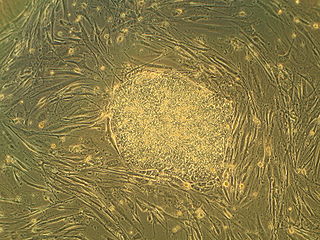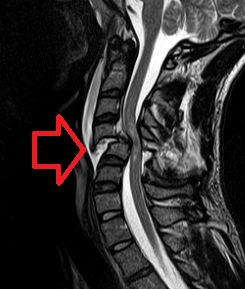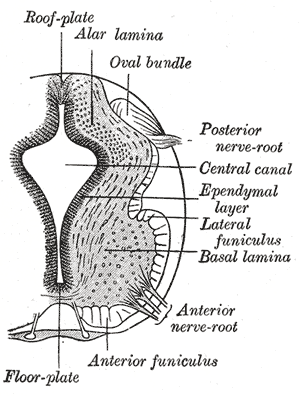
In multicellular organisms, stem cells are undifferentiated or partially differentiated cells that can change into various types of cells and proliferate indefinitely to produce more of the same stem cell. They are the earliest type of cell in a cell lineage. They are found in both embryonic and adult organisms, but they have slightly different properties in each. They are usually distinguished from progenitor cells, which cannot divide indefinitely, and precursor or blast cells, which are usually committed to differentiating into one cell type.

Christopher D'Olier Reeve was an American actor, activist, director, and author. He amassed several stage and screen credits in his 34-year career, including playing the title character in the Superman film series (1978–1987). He won a British Academy Film Award, an Emmy Award, a Grammy Award and a Screen Actors Guild Award. He was also known for his activism.

Embryonic stem cells (ESCs) are pluripotent stem cells derived from the inner cell mass of a blastocyst, an early-stage pre-implantation embryo. Human embryos reach the blastocyst stage 4–5 days post fertilization, at which time they consist of 50–150 cells. Isolating the inner cell mass (embryoblast) using immunosurgery results in destruction of the blastocyst, a process which raises ethical issues, including whether or not embryos at the pre-implantation stage have the same moral considerations as embryos in the post-implantation stage of development.

A spinal cord injury (SCI) is damage to the spinal cord that causes temporary or permanent changes in its function. It is a destructive neurological and pathological state that causes major motor, sensory and autonomic dysfunctions.
The California Institute for Regenerative Medicine (CIRM) is a state agency that supports research and education in the fields of stem cell and gene therapies. It was created in 2004 after 59% of California voters approved California Proposition 71: the Research and Cures Initiative, which allocated $3 billion to fund stem cell research in California. In 2020 voters approved Proposition 14 that allocated additional funds to CIRM.

Regenerative medicine deals with the "process of replacing, engineering or regenerating human or animal cells, tissues or organs to restore or establish normal function". This field holds the promise of engineering damaged tissues and organs by stimulating the body's own repair mechanisms to functionally heal previously irreparable tissues or organs.

Proposition 71 of 2004 is a law enacted by California voters to support stem cell research in the state. It was proposed by means of the initiative process and approved in the 2004 state elections on November 2. The Act amended both the Constitution of California and the Health and Safety Code.

The stem cell controversy concerns the ethics of research involving the development and use of human embryos. Most commonly, this controversy focuses on embryonic stem cells. Not all stem cell research involves human embryos. For example, adult stem cells, amniotic stem cells, and induced pluripotent stem cells do not involve creating, using, or destroying human embryos, and thus are minimally, if at all, controversial. Many less controversial sources of acquiring stem cells include using cells from the umbilical cord, breast milk, and bone marrow, which are not pluripotent.
Stem-cell therapy uses stem cells to treat or prevent a disease or condition. As of 2024, the only FDA-approved therapy using stem cells is hematopoietic stem cell transplantation. This usually takes the form of a bone marrow or peripheral blood stem cell transplantation, but the cells can also be derived from umbilical cord blood. Research is underway to develop various sources for stem cells as well as to apply stem-cell treatments for neurodegenerative diseases and conditions such as diabetes and heart disease.

ITVS is a service in the United States which funds and presents documentaries on public television through distribution by PBS and American Public Television, new media projects on the Internet, and the weekly series Independent Lens on PBS. Aside from Independent Lens, ITVS funded and produced films for more than 40 television hours per year on the PBS series POV, Frontline, American Masters and American Experience. Some ITVS programs are produced along with organizations like Latino Public Broadcasting and KQED.

The floor plate is a structure integral to the developing nervous system of vertebrate organisms. Located on the ventral midline of the embryonic neural tube, the floor plate is a specialized glial structure that spans the anteroposterior axis from the midbrain to the tail regions. It has been shown that the floor plate is conserved among vertebrates, such as zebrafish and mice, with homologous structures in invertebrates such as the fruit fly Drosophila and the nematode C. elegans. Functionally, the structure serves as an organizer to ventralize tissues in the embryo as well as to guide neuronal positioning and differentiation along the dorsoventral axis of the neural tube.
Kartemquin Films is a four-time Oscar-nominated 501(c)3 non-profit production company located in Chicago, Illinois, that produces a wide range of documentary films. It is the documentary filmmaking home of acclaimed producers such as Gordon Quinn, Steve James, Peter Gilbert, Maria Finitzo, Joanna Rudnick, Bing Liu, Aaron Wickenden, and Ashley O’Shay (Unapologetic).
Gordon Quinn is artistic director and founding member of Kartemquin Films and a 2007 recipient of the MacArthur Award for Creative and Effective Institutions. Gordon Quinn has been making documentaries for over 45 years and has produced or directed over 30 films. His recent directing credits include Prisoner of Her Past and A Good Man. His producing credits include the films Hoop Dreams; In the Family;Vietnam, Long Time Coming; Golub: Late Works Are the Catastrophes; 5 Girls; Refrigerator Mothers; and Stevie. Most recently, Gordon executive produced Mapping Stem Cell Research: Terra Incognita and The New Americans, for which he directed the Palestinian segment. Currently, he is executive producing several new films for Kartemquin.

The Allen Institute for Brain Science is a division of the Allen Institute, based in Seattle, Washington, that focuses on bioscience research. Founded in 2003, it is dedicated to accelerating the understanding of how the human brain works. With the intent of catalyzing brain research in different areas, the Allen Institute provides free data and tools to scientists.
Su-Chun Zhang, is an American stem cell researcher at Duke-NUS Medical School in Singapore and the University of Wisconsin–Madison.
Sally Temple is an American developmental neuroscientist in Albany, New York. She is a co-founder and scientific director for The Neural Stem Cell Institute and is a professor of Neuroscience and Neuropharmacology at Albany Medical College Temple is also the principal investigator in her laboratory that focuses on neural stem cells and therapies for neurological-related disorders
The Food and Drug Administration (FDA) approved the first clinical trial in the United States involving human embryonic stem cells on January 23, 2009. Geron Corporation, a biotechnology firm located in Menlo Park, California, originally planned to enroll ten patients with spinal cord injuries to participate in the trial. The company hoped that GRNOPC1, a product derived from human embryonic stem cells, would stimulate nerve growth in patients with debilitating damage to the spinal cord. The trial began in 2010 after being delayed by the FDA because cysts were found on mice injected with these cells, and safety concerns were raised.
Spinal cord injury research seeks new ways to cure or treat spinal cord injury in order to lessen the debilitating effects of the injury in the short or long term. There is no cure for SCI, and current treatments are mostly focused on spinal cord injury rehabilitation and management of the secondary effects of the condition. Two major areas of research include neuroprotection, ways to prevent damage to cells caused by biological processes that take place in the body after the injury, and neuroregeneration, regrowing or replacing damaged neural circuits.

Hans Keirstead is a medical scientist and entrepreneur specializing in stem cell research.

Mark York, also known as Marcus A. York, was an American actor best known for his role as Billy Merchant in NBC's The Office. He also had roles in CSI: NY, 8 Simple Rules, and A.I. Artificial Intelligence (2001).











